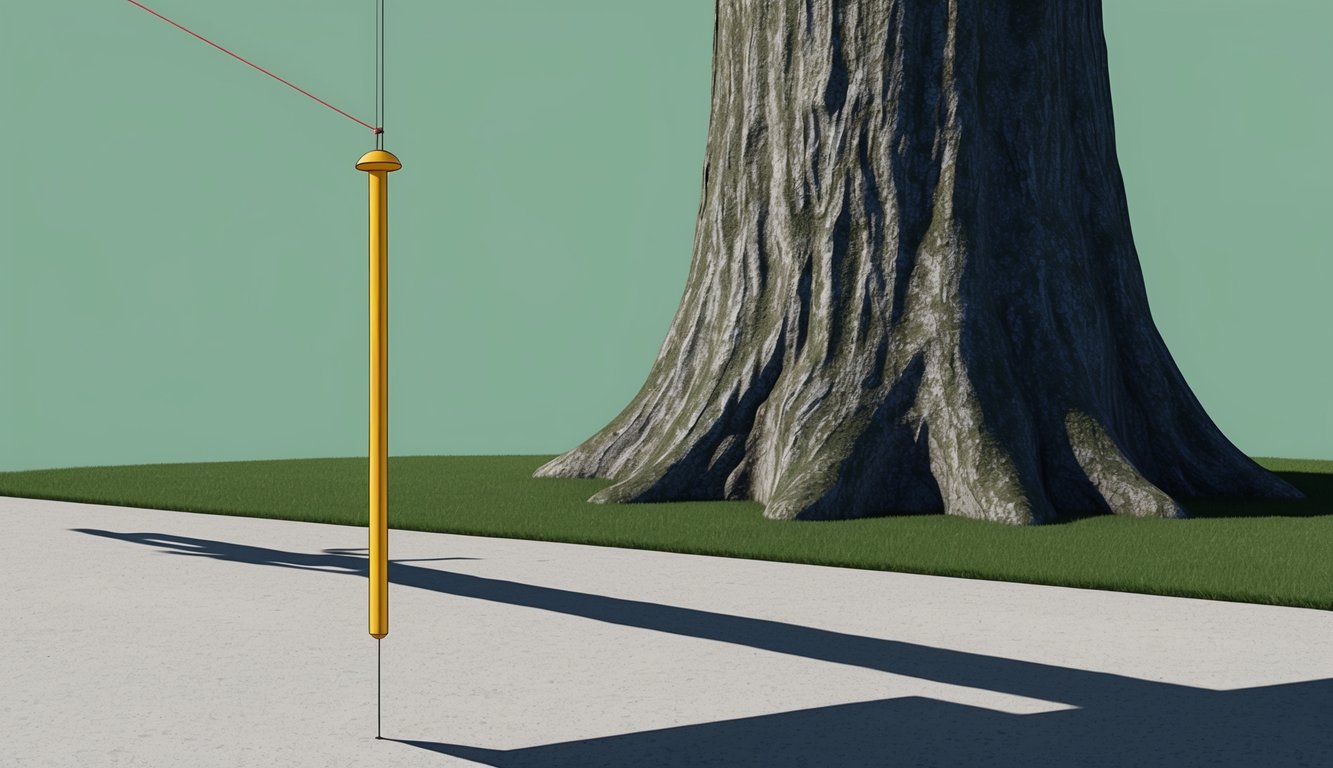Don’t Miss Out On This Unique Astrological Opportunity
Are you tired of spinning your wheels and getting nowhere? Simply put, you’re out of sync: you’re out of alignment with your astral configuration.
But: there’s a kind of map that can help you reclaim your alignment. Think of it as your own personal blueprint to success and happiness: a blueprint that will help you live your most amazing life.
Get started here.
The plumb line is a simple yet essential tool used to measure vertical alignment.
Builders and architects have used it for centuries to ensure structures are upright and stable.
This straightforward piece of equipment relies on gravity, making it incredibly reliable and easy to use.
Beyond construction, the plumb line has impacted various fields and has symbolic significance in art and literature, representing truth and integrity.
Its ability to reveal perfect vertical alignment has made it invaluable in areas where precision is critical.
From aligning towering skyscrapers to ensuring a picture hangs straight on a wall, the plumb line’s uses are diverse and widespread.
Whether you are curious about its practical applications or intrigued by its metaphorical meanings, understanding the plumb line’s role can deepen your appreciation for this timeless instrument.
Its blend of simplicity and effectiveness continues to make it relevant across different domains.
Key Takeaways
- The plumb line is vital for vertical measurements.
- It’s historically significant in building practices.
- It has symbolic meanings beyond its practical use.
Historical Significance of Plumb Lines
Plumb lines have been a vital tool in architecture and literature, serving as symbols of precision and order.
Their influence spans from ancient construction methods to scriptural metaphors, and they’ve continually evolved to meet human needs.
Plumb Lines in Ancient Construction
Plumb lines, or plumb bobs, have roots in ancient architecture.
They were essential tools for ensuring the vertical alignment of structures, often used in foundation work.
The name derives from the Latin “plumbum,” meaning lead, the material commonly used for the weight.
These tools were critical in building significant structures, such as the pyramids of Egypt.
The precision afforded by plumb lines allowed builders to create massive edifices with remarkable accuracy.
They ensured that walls were straight and aligned, minimizing the risks of collapse.
Plumb Lines in Scripture
Plumb lines also carry symbolic weight in religious texts.
They appear in the Bible as metaphors for justice and righteousness.
In the book of Amos, God uses a plumb line to illustrate Israel’s moral failings.
Similarly, Isaiah and Zechariah mention plumb lines in various contexts, often highlighting divine judgment or guidance.
This imagery reinforces the idea that moral integrity is measured against a divine standard, much like a builder ensures structural soundness with a plumb line.
Some scholars even draw connections between these biblical metaphors and bible verses predicting modern events, suggesting that ancient warnings about justice and righteousness remain relevant today.
By examining these passages, readers can gain insight into how spiritual teachings continue to shape contemporary ethical discussions.
These scriptural references emphasize the importance of alignment—not just physically, but morally and spiritually.
The plumb line serves as a symbol of truth and integrity, measuring the faithfulness and righteousness of God’s people, acting as a divine standard.
Evolution of the Plumb Line as a Tool
Over time, the plumb line has evolved, maintaining its fundamental principles while adapting to modern needs.
Today, they are still used in construction but have seen competition from newer technologies like laser levels.
Despite this, the practicality and simplicity of traditional plumb lines make them indispensable for many builders.
Modern usage has expanded beyond construction.
Plumb lines are now employed in a variety of fields, including surveying and navigation.
Their accuracy and simplicity continue to make them a valuable tool, bridging ancient methods with contemporary applications.
Scientific Principles Behind Plumb Lines
Plumb lines are tools that rely on the force of gravity to indicate a true vertical line, critical in various surveying and construction tasks.
Understanding how gravity affects plumb lines can help you grasp their importance in achieving verticality and alignment.
Gravity and the Plumb Line
Gravity is the key force at play with a plumb line.
When you suspend a weight (usually called a plumb bob) from a string, gravity pulls it to the lowest possible point.
This causes the string to hang straight down, creating a vertical line.
This vertical line is essential for determining true plumb, which means perfectly vertical.
In construction and architecture, ensuring structures are aligned correctly starts with using a plumb line.
The weight at the end concentrates the force of gravity, making it possible for you to visualize this invisible line accurately.
The design of the plumb line ensures consistent performance, as gravity is a constant force worldwide, making this tool both simple and universally reliable.
Understanding Verticality and Alignment
A plumb line helps you achieve verticality by providing a clear reference line from which vertical alignment can be checked.
Verticality refers to how close your current line or structure aligns with a true vertical line.
For instance, you can use a plumb line to check if walls are level during construction by hanging the line against them.
When the line stays parallel to a structure, it indicates proper alignment.
This ensures that the center of gravity remains well-positioned within the base, which is critical for stability.
In contexts like carpentry and masonry, using a plumb line can mean the difference between structural soundness and potential failure.
By properly aligning components, you ensure the load is evenly distributed, maintaining the integrity of the building or object.
Practical Applications of Plumb Lines

Plumb lines play a crucial role in many fields by ensuring vertical precision.
They offer accurate alignment for structures and components, benefiting builders and carpenters alike.
Plumb Lines in Building and Construction
In building and construction, plumb lines are essential for setting up walls and structures.
Builders use them to ensure walls are precisely vertical, which is fundamental for stability.
By using a plumb bob, you can find the exact point where a structure aligns vertically with the earth’s gravity.
This helps with aligning columns and positioning scaffolding safely.
Plumb lines also help in marking a datum mark, a reference point on walls crucial for guiding further construction tasks.
By maintaining a true vertical alignment, buildings not only stand strong but also look architecturally pleasing.
This method has been used for centuries and remains a foundation in modern construction practices.
Use in Carpentry and Masonry
Carpenters rely on plumb lines to ensure the upright positioning of frames and posts.
By doing so, they can confirm that structural elements are not leaning, which could compromise stability.
These lines help manage the weight distribution in structures, supporting overall integrity.
In masonry, plumb lines are used to build straight and true walls, ensuring bricks and stones are placed at the correct angle.
Plumb lines are also handy when installing pipes, ensuring they run vertically through buildings.
This accuracy is crucial for systems that require proper alignment to function efficiently, such as plumbing conduits.
Modern Devices and Improvements
While traditional plumb lines are still in use, modern alternatives have emerged, providing greater precision and ease.
Laser levels are often used in construction and carpentry for horizontal and vertical alignment.
These tools have automatic leveling systems that enhance efficiency by projecting accurate lines quickly.
Builders and carpenters utilize electronic devices for tasks from installing wall panels to fitting shelving, offering a faster setup process.
Though technology has advanced, the principle of the plumb line remains integral, with contemporary tools reflecting its enduring importance.
Your choice of tool depends on the task, balancing tradition with modern efficiency.
Symbolic and Metaphorical Uses of the Plumb Line

The plumb line is more than a tool for measuring verticality.
It represents concepts like righteousness and justice, and it holds significant meaning in spiritual teachings.
By understanding these symbolic uses, you gain insight into moral law and the standards of faith.
Moral and Ethical Metaphors
In moral and ethical contexts, the plumb line symbolizes righteousness and justice.
It serves as a standard against which actions are measured.
Imagine it as a tool to discern what is straight and just compared to what is crooked.
In Scripture, prophets like Amos used the plumb line to convey messages about moral law to the people of Israel.
This tool’s metaphorical power lies in its use to highlight the difference between right and wrong.
The plumb line represents a clear standard, pushing you to evaluate moral actions critically.
It urges one to align moral conduct with established ethical norms, resembling how a builder checks for straightness.
Plumb Line and Spiritual Teachings
In spiritual teachings, the plumb line goes beyond earthly measurements.
It reflects your faith and spiritual convictions.
For Christians, the plumb line can symbolize Christ’s teachings, acting as a guide to maintain spiritual integrity.
In Biblical texts, it often indicates God’s standard for righteousness that believers are encouraged to follow.
The plumb line asks for alignment not just in actions, but in faith and belief.
By using this symbol, you are reminded of the divine standards set before you, urging spiritual introspection and growth.
The effective use of this symbol in spiritual contexts underscores a quest for aligning with divine justice and righteousness.
Frequently Asked Questions

A plumb line is a simple tool yet holds various applications across different fields.
From construction to surveying, medicine to physics, and even in biblical symbolism, this tool helps guide precision and balance.
How does a plumb line function in establishing vertical reference?
A plumb line uses gravity to establish a true vertical line.
When suspended, the weight at the end of a string ensures that the line points straight down.
This is crucial in construction to ensure structures are upright.
In what way is a plumb line utilized in surveying?
In surveying, a plumb line helps transfer points from a map to the ground accurately.
It maintains alignment by ensuring points are vertically aligned, aiding in drawing straight and true lines for buildings or land measurements.
Can you explain the significance of a plumb line in a medical context?
In medicine, particularly in spinal assessments, a plumb line helps determine alignment.
It is used to check for deviations in posture or spinal alignment by seeing how the body aligns with the vertical line from C7 vertebra downward.
What are practical applications of a plumb line in physics?
In physics, plumb lines are involved in experiments to teaching basic gravitational principles.
They help demonstrate the concept of gravitational force by showing how a weight suspended from a string aligns with the force of gravity, creating a vertical reference.
How does one interpret the symbolism of a plumb line in the Bible?
In biblical texts, a plumb line symbolizes judgment and righteousness.
It is used to represent God’s perfect standards, where a plumb line checks if one, or a group, aligns with divine principles and values, symbolizing moral guidance and integrity.
What are the implications of using a plumb line for assessing posture?
Using a plumb line for posture assessment helps in evaluating an individual’s alignment.
Professionals can identify postural issues and recommend corrective measures by analyzing how the body lines up with the plumb line.
This is frequently applied in physical therapy and chiropractic assessments.



